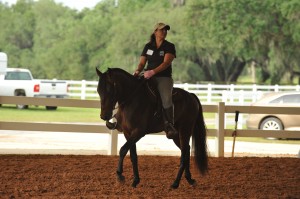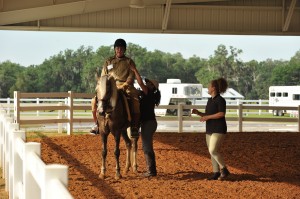
We all had a taste of riding and training under Kate’s expert guidance. Kate was able to ride each of the Marchadors herself to understand the movement and what it might need. She brought with her a toolkit and recommended different things with each horse, sometimes changing to a milder bit. Because she only had a short time with each horse and rider, she worked on getting the rider to feel the marcha when it was correct. Then they could recreate it when they got home.
The quality of the marcha is based on many components, not just smoothness. So, there was some range in the smoothness of the gait, the extension, the lift of the front legs and the expression of the movement (as compared to the “diagram” that should be in your head at all times.) Part of the answer in the difference was in conformation, which Tiago evaluated on every horse at the clinic with the owner and sometimes the breeder paying close attention!

The Brasilians have a complicated and precise expectation about each body part, the angles, the length and the proportion to one another. Both the conformation and the marcha are evaluated and tested on all Marchadors being registered in Brasil by the ABCCMM. Some breeders in the U.S. like us, also follow that tradition. SW Future Foal is an ABCCMM breeder.
These measurements and evaluation relate to the horse being able to move and flex the front legs and the back legs in a similar fashion. In the marcha, the front leg hits before the opposite hind leg – this is called dis-association and it’s why it is a marcha and not a trot. There is often over reach where the hind legs hit in front of where the front legs landed.
Surprisingly, all but one of the Marchadors in the clinic were marcha batida horses, even though some owners had believed perhaps that they were marcha picada because they were so smooth.

So much valuable information given to each rider and owner! Much of it was videotaped and I will be producing videos all summer so that we don’t forget!
From this year’s clinic, here are the learnings that are ringing in my ears from Tiago and Kate.
“There are 5 senses to help you feel that the marcha is correct. Two eyes (if you are watching). Two ears (close your eyes and listen). One seat. (you can feel it).”
“Relax your horse – the neck must be flexible and supple.”
“Don’t bounce or post! Relax your hips and move with the horse.” If you move up and down the horse will follow you and not stay smooth.
“Keep your hands steady with his mouth, but relax your arms and shoulders.” I found this instruction fascinating. How can I keep my hands set but keep my shoulders relaxed? But yes, you can do it. If your shoulders are not relaxed, your hands will not be quiet.
“More speed! More leg!” Most of us here in the U.S. seem to be riding our Marchadors way too slow for them to find their way. The marcha has speeds and often the horses smooth out at higher speed, almost at a canter.
“Disassociation” The rider should be able to feel AND hear that the hind feet are not hitting the ground at the same moment as the front feet. The shoulders and hips of the horse should be swinging free and easy. That’s why it’s so important that the horse stay relaxed. And it’s also why some horses get smoother after they warm up.
“Inside rein. Move your fingers!” To keep the head flexed and neck bent and soft.
“Breathe!” To keep you soft.

Here’s what I wrote up after the 2011 Clinic and it is remains the same too.
- Perfect the 4 beat extended walk. (How many times are we told to practice a good walk in other disciplines?) It is ESSENTIAL for a good marcha as it is the take-off point and retreat point always.
- Practice in straight lines before teaching in circles, lateral work or ANY other discipline. Teach the horse to elongate his back, his stride, relax and stretch without speeding up.
- Always start on the good side for the stretches, but do both sides. Stretching from the good side will help the bad side to stretch easier.
- To move into gait: From the walk, apply more leg pressure and ask the horse to speed up without losing the smooth rhythm that was there in his walk. Collect the reins (have contact) with the horse’s mouth to ask him to collect his body in a good frame.
- Do NOT let your horse continue to gait if it is gaiting badly. Go back to the walk and start again.
- On the other hand, keep the marcha going for long and longer periods of time. Don’t stop! Ask for MORE SPEED from his legs while maintaining the collection. You are trying to build MUSCLE MEMORY. (This works really well! I tried it on my horses after the clinic)
- A marcha picada horse that paces is often still very smooth (I was surprised by this). You can tell because your hips will go side to side instead of forward and back. Try to put your leg on for more leg speed, but if that doesn’t work, return to the walk and start over.
- Place your horse on the marcha gait line L4-D4. Some horses will need training help because of poorer conformation or genetics, but some horses might need help because someone interfered with their natural gait during training. The Marchador is a willing partner. If you ask it to change its natural footfall, it will learn to do what you want.
- You can use dressage to supple the horse and build muscle, but not too soon (remember straight lines). Once you can do the circles, you can move to a higher-level figure. The Marchador can do lateral work and the higher moves IN GAIT! (Another surprise for me!)
Click here if you want to read the whole SW News article: SW News411
Also, for Kate’s slides from the 2011 Clinic, follow this link: https://www.namarchador.org/2012/04/mm-clinic-slides-2011/

One thought on “SW Update — Clinic, Marcha Gaits 2!”